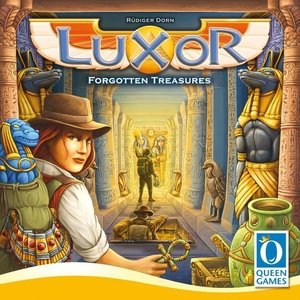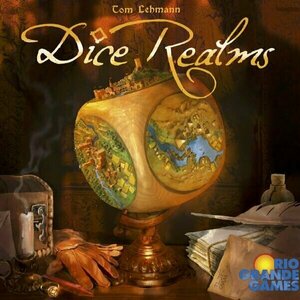
iPeng 9 - Squeezebox Remote
Music and Utilities
App
iPeng 9, the music remote for the Logitech® Squeezebox™, has been designed for the latest iOS...

GSE SMART IPTV PRO
Entertainment and Photo & Video
App
Support : CHROMECAST Support : XTREAM-CODES API Support : Web interface playlist management - Web...

Russ Bray Darts Scorer
Sports and Entertainment
App
// HAVE THE PDC WORLD FINAL REFEREE RUSS BRAY CALLING YOUR MATCHES!! // ***** 5 star award in Apps...

Luxor (2018)
Tabletop Game
On the hunt for priceless treasures, groups of adventurers explore the legendary temple at Luxor....
Boardgames QueenGames DornGames

Dice Realms
Tabletop Game
In Dice Realms, players vie to improve and expand their realms, which are represented by...
Purple Phoenix Games (2266 KP) rated Gift of Tulips in Tabletop Games
Mar 2, 2021
Gift of Tulips is a game of choices. In it players are attendees at the festival attempting to gather the most beautiful bouquet of flowers for themselves as well as gifting some to friends. The winner of the game is the player who can best decide which tulips should be kept, which should be gifted, and which should be donated to the secret festival.
DISCLAIMER: We were provided a prototype copy of this game for the purposes of this review. These are preview copy components, and I do not know for sure if the final components will be any different from these shown. Also, it is not my intention to detail every rule in the game, as there are just too many. You are invited to download the rulebook, back the game through the Kickstarter campaign, or through any retailers stocking it after fulfillment. -T
To setup refer to the rulebook to adjust the deck of tulip cards per number of players. Shuffle this deck and place aside for now. Each player receives a scoring card, reference card, favorite color player cube, and two tulip cards from the deck. Per number of players set the appropriate Festival Cards on the table from 1st Place through 4th Place. Draw two cards from the deck and place the highest-numbered card under the 1st Place Festival Card and the lower valued tulip card under 2nd Place. Each player then looks at their dealt cards and decides which they would like to keep to start their personal bouquet and which they wish to donate face-down to the secret festival stack. The game is now ready to begin!
On a turn the active player will draw one card from the deck and then perform one action. Next they will draw a second card and perform a different action (not the same action as the first). The available actions are keeping a tulip for the bouquet, gifting the tulip to a friend, or adding a card to either the festival or the secret festival stack.
Keeping a tulip for the player’s bouquet is simply that: place the card face-up in front of the player and score immediate points depending on the tulip type’s position in the festival. This is also important when scoring for gifting. As tulips are added to their types in the festival, their placement in the festival can change. So while a purple tulip, for example, begins the game as the highest numbered tulip in the 1st position, another tulip type, orange maybe, may possibly overtake the 1st position cards by having a larger total value in tulips. When this happens, the newly-increased-in-rank tulip stack pushes the next highest into the lower position. Each position’s festival card will contain icons that award points for when that type of tulip is kept, given, and when majority of cards is owned at endgame.
Similarly, when a player opts to gift a tulip for an action, they simply choose an opponent (well, friend) and give them the card. By referencing the tulip type’s current position in the festival the player may score immediate points.
Lastly the player may choose to donate their tulip to the festival (face-up under the Festival Cards or face-down into the secret festival stack). By donating to the festival proper they will add the card to the appropriate type stack and adjust the total value and position within the festival. Should the player wish to add the card to the secret festival stack, they simply add it face-down.
Once all cards have been drawn and played from the deck the game is over and final scoring may begin. Firstly the secret festival cards are to be shuffled and five from this deck will be added to the festival proper to fine-tune some value adjustments (so that is why players may want to add to the secret festival during play). Once the five cards have been added players will address each tulip type by placement in the festival. The tulip type under the 1st Place card will score majority points to the player with the majority of that type of card (not value, but number of flowers). Similarly, the player with the second most of that type will score the second majority and so on through 4th Place. The player with the most points at the end of the game has won and will now owe the other players a bouquet of real flowers. Well, maybe not that last part.
Components. Again, this is a prototype copy of the game so components may be different as a result of a successful Kickstarter campaign. That said, this is a bunch of cards and some token markers (cubes in the prototype). The cards all feature incredible botanical artwork that is simply beautiful to behold. The card backs and Festival Cards all feature a lovely delftware pattern from the Netherlands. The artwork on this game is amazing and really colorful, like so many from Weird Giraffe Games.
But do I enjoy the gameplay? Absolutely. It reminds my wife and me of a great little game called Biblios where players are choosing where to allocate cards, and are not allowed to simply gobble them for themselves. Being able to adjust the market, if you will, is also a mechanic that I truly enjoy. A static market is fine, but those kinds of games are a little easier to abuse. Constantly shifting markets is where it’s at.
Being able to gift your opponents higher cards for those immediate points is new and clever, but you have to always be keeping track of the number of cards given per type. Obviously shuffling all your blue tulips to the same person may result in that person holding majority at endgame. But then again, there are ways to adjust the market to counter that. It is just so fun to think about and play.
I also am in love with the art. I mentioned this in my components review but I simply love the way this game looks. Art and theme go a long way with me, and this one certainly has both in spades.
So if you are a fan of beautiful games with a quick teach and light to medium gameplay, I urge you to check this out. The art and theme are strong, the gameplay is super solid and fun, and you feel great donating so many lovely flowers at the end of the game. If you are looking for that gorgeous game to complete your collection, or you need a game to fill that empty Netherlands slot in your collection, please consider backing Gift of Tulips. When you have a game that uses both orange and purple as main colors you KNOW it’s going to be great!
Purple Phoenix Games (2266 KP) rated Mob Sitters in Tabletop Games
Sep 17, 2019
Disclaimer: This preview is based upon a preview copy of the game. The final components, rules, and gameplay may differ from those described in this review! -L
In Mob Sitters, you take on the role of a babysitter working for the mob. Just because crime pays the bills doesn’t mean these mobsters don’t have families! You’re no ordinary babysitter though, otherwise you wouldn’t be mixed up with the mob. You’ve got plans of your own – whether it’s stealing from your boss, ratting out your rivals to the cops, or actually just some innocent babysitting, there’s money to be made here!
Mob Sitters is played over six rounds in which you take turns playing cards (some hidden and some not), targeting or reacting to your opponents, and collecting that sweet sweet money. Let’s break it down. To start the game, each player receives a player mat and deck of cards for their chosen character. There will be 8 characters in the final game, but only 6 are present in the preview copy. The different characters do not have any special powers or abilities, they just have different artwork on their cards! Shuffle your decks, draw a hand of 6 cards, determine a starting player, and you’re ready to go.
Each player’s turn consists of 6 steps (Steps 1-3 are not applicable in round 1, and Steps 4-6 are not applicable in the final round). Step 1 is to earn money – any cards with a monetary value that are in your play area are moved to your Safe and will count towards end-game scoring. It is important to note that cards that earn you money (Steal and Job cards) must be played face-up into your play area. Step 2 is to reveal and resolve any Accusation cards in your play area that you want to. Accusation cards allow you to target an opponent’s Job/Steal card currently in play, in an attempt to discard it to their Cops/Boss piles, respectively, to count against that player in end-game scoring. The targeted player does not have to sit idly by and watch their money go down the drain, however. If the targeted player has a Reaction card face-down in their play area, they may reveal it to deflect the blame to yet another player! If you successfully deflect the blame, that money will not count against you, but will instead count against the next player blamed who is unable to react to and shift blame to someone else. To play a Reaction card, it must already be in your play area – you cannot play one directly from your hand! The next step, Step 3, is to discard any remaining face down cards in your play area. In Step 4, you choose 3 cards from your hand and play them into your play area. Job/Steal cards must be played face-up, but Accusation and Reaction cards can be played face-down. During Step 5, you resolve any face-up accusation cards you may have played in Step 4. The final step, Step 6, of your turn is to draw 3 cards, bringing your hand back up to 6 cards. Play then moves on to the next player, who then will perform their 6 steps, and so on. After 6 rounds, the game ends. Scoring varies depending on how many players there are, but ultimately the winner is the player with the most money in their safe!
I know that sounds like quite a lot going on, but believe me when I say the game plays pretty well (and pretty quickly) once you’ve gotten the hang of the turns. On paper, the sheer number of steps per turn seems excessive and like it would bog down the gameplay, but in actuality, the actions performed in each step are simple and fast. Perhaps if the number of steps were condensed from 6 down to maybe 3-4, the gameplay would seem a little less daunting. There is some slight ambiguity between the types of cards and into which stacks they go – the rules call cards Job and Steal cards, but the player mat refers to Boss and Cop cards. Fortunately the cards have symbols that correspond to the different stacks, so when in doubt, check the corner of the card!
Let’s talk components. This is first and foremost a card game, and the cards I received are of good quality! They shuffle well, and feel sturdy enough to withstand many plays. The art on the cards is pretty cute, the colors really pop, and there are some fun puns to be found on several Steal/Job cards. As for the player mats, this is only a preview copy of the game so I just printed them out (apologies for my lack of access to a color printer!), but their text is clear and helpful for remembering turn steps. The components may change throughout the Kickstarter campaign, but so far they’re off to a good start!
So how does it play? For the most part, Mob Sitters plays pretty quickly and is engaging for all players. There’s a good amount of strategy involved, as well as some luck and a whole lotta take that. All players receive identical decks of cards, which are then shuffled, so although you know what cards are available to your opponents, you never know what they currently have in their hand. You’ve got to be watchful of which cards your opponents play, to see if you can deduce which cards they have remaining. Are they taking the offensive approach and accusing everyone? Or are they being more subtle and taking a defensive stance, deflecting all accusations onto others? You have to decide when is the right time to play your cards to ensure that you aren’t targeted by too many opponents. Your strategy is ever-changing to adapt to the cards currently in your hand, and that’s what takes Mob Sitters to the next level for me.
Mob Sitters is a quick, easy, and fun game for any sized group. Hilarity ensues when accusations result in all players pointing fingers and trying to deflect blame. Although it can be played with 3, I think this game is better suited for 4+ players. With a smaller group, some of the aspects of ‘take that’ can feel personal and lead to tension between players. But a larger group can eliminate some of the animosity caused by always being targeted by the same person the entire game. Overall though, I enjoyed getting to play Mob Sitters! It has a unique theme and simple, yet strategic, gameplay that will keep all players on their toes. In my communications with the designer, I have learned that the retail version of the game will include “Hidden Agenda” cards to provide each player with a secret objective. There is also an expansion already in the works – The Heavy Mob Deck – that will add more cards and more complexity for experienced gamers!
If you enjoy games of hidden information, take that, and a little bit of bluffing, definitely check Mob Sitters out! It’s more than the standard party game, but still fits the categories of light, fast, and easy to learn games for all players. I look forward to following this upcoming campaign, and I definitely will be playing my copy again!
Purple Phoenix Games (2266 KP) rated Holi: Festival of Colors in Tabletop Games
Apr 16, 2022
Holi is an abstract, area control, card-driven action selection (akin to Onitama) game for two to four players. In it, players are attendees at the Holi Festival and the goal is spread their favorite color onto the plaza and other players in order to increase their joy (earn VP). The winner is the player who is best able to throw their color and score joy, all while enjoying the festival!
To setup, the game owner will assemble the three-tiered board and place the appropriate sweets tokens on their spaces. The score track and Rivalry cards are set nearby so all can see. Each player receives their color’s player markers (in four delightful animal shapes), color tokens, color cards, and a helper card. The first player receives the cool lotus flower (I think) marker and the game may begin!
Holi is played over a series of turns, and continues until every player has either run out of color tokens or color cards to play. Each turn, players will take one to three actions in any order, with only one action being absolutely mandatory. This is the Throw Color action. In order to Throw Color, the active player will choose a color card from their hand of three cards to play. On these cards are indications of where a player’s marker/piece/animeeple must be located and the spaces near it to throw color tokens on the board. These color cards are reminiscent of those found in Onitama, where players may only move to specific spaces based on card grid iconography. Players will be littering the squares of the play area with their color tokens as well as attempting to hit other players’ animeeples with their color.
Players may also optionally Move at any point during the turn. This is an easy one: players may Move to any space on the current level of the board they are on, except any space inhabited by an opponent’s animeeple. These spaces could already contain sweets tokens, which can be collected by the player, or even color tokens. When a player lands in a space with their own color token, they take it back to their supply to be used again. However, landing on an opponent’s color token causes the active player to also take it into their supply, thus scoring the opponent points at the end of the game.
Finally, a player, if in a space surrounded on four edges by color tokens, may Climb Up to the next higher level. Players on the middle level will score 2 joy (VP) at the end of the game for each color token placed, while tokens on the top level will score 3 joy. Care should be taken when throwing color on the upper levels, because should an empty space reside on the level below where the token has been placed, the token will fall through to the lower level! Therefore, only color tokens will only remain placed on higher levels when another token is blocking its fall below it.
Once all players have played their cards and thrown their color tokens, the game is over and the score is tallied. 1 point is earned for each color token on the bottom level, 2 points for the middle level, and 3 points for tokens on the upper level. Players score 2 more points for each of their color tokens that found their way into opponents’ supplies. Remember those sweets tokens that players were collecting? Players will score 5 points for every player that has less sweets tokens at the end of the game. If playing with the Rivalry cards, points are also scored for any of their special circumstances (ie color tokens scoring 4 instead of 3 on the top level, or hitting opponents with colors score 2 points immediately instead of the normal 1 point, or even 10 bonus points to the player with the most color tokens on the bottom level). The player with the most points at the end of this scoring phase wins the game!
Components. I kind of already made my point about this game being a flat out stunner on the table. I will sing its praises from here to India and then back again. I normally acknowledge the artist(s) on a game once I open it for the first time, but seeing that this is a total Vincent Dutrait masterpiece, I just had to see which other games of his I own. I have made my claims in the past for my favorite board game artists and I had not included Dutrait. No more. This is brilliant and just a wonderful experience throughout. The components are all great, and that multi-layered board? I mean, come on! The intricacies found throughout and within this box are immeasurable, and I will surely be adding the Deluxe version to my collection.
Holi is a game I can pull out with almost any person or group of people and feel confident that it will give an extremely satisfying experience. The rules are relatively simple, and games are very quick. This is not a filler, but runs so smoothly and briskly that one may miscategorize it as such. The options of movement are so unrestricted, and having the ability to craft spatial situations with the cards in your hand to allow only your animeeple to climb up to the next level is just delicious. Speaking of, the sweets tokens, and really ALL of the components, are just so cute and well-illustrated. I really am finding it difficult to point out any flaws in this game. Every time I have played it I have simply had the best time with my opponents. Yeah, there’s some minor take that, but it’s all in good fun, and if you know anything about the actual celebration of Holi, participants relish coming home just covered head to toe in paint, colored water, and other colorful materials. It’s a great theme that shines through, and I look forward to each of my coming plays.
Currently, eight games we have published reviews for have earned the Golden Feather Award. At the time of this writing, I know one other will be joining that list soon, and now Holi will as well. So that is 10 total games over the 495 we have published and are sitting in queue to be published. That said, it is no surprise, I’m sure, that Holi has earned its spot among the best we have played, and I am incredibly relieved that I was able to grab a copy when I did. This will remain a favorite of mine for many years, I know it. If you are like me and appreciate an amazing production value with a comparably wonderful game underneath, then you owe it to yourself to pick up a copy of Holi as soon as you can. Or come play my copy with me. I will always be up for a play.
Entertainment Editor (1988 KP) rated Sushi Go Party! in Tabletop Games
Mar 8, 2018
Reviewer: Jennifer Derrick
Read the full review here: http://islaythedragon.com/featured/lets-get-this-party-rolling-a-review-of-sushi-go-party/




